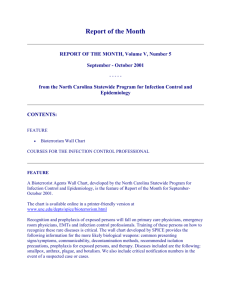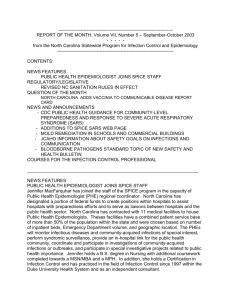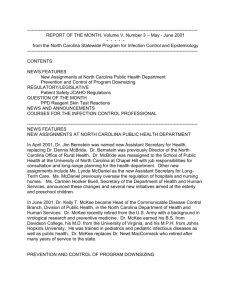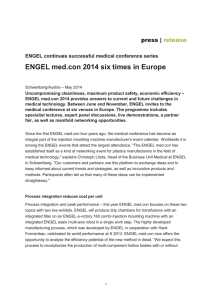Vol VI No 2
advertisement
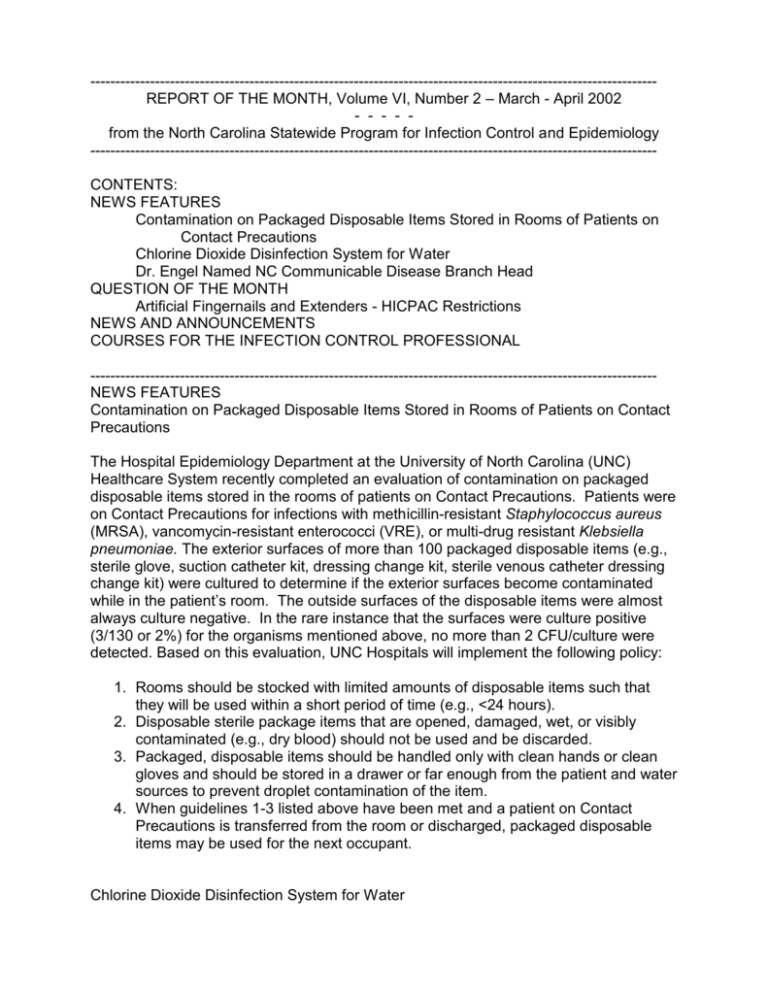
-----------------------------------------------------------------------------------------------------------------REPORT OF THE MONTH, Volume VI, Number 2 – March - April 2002 - - - - from the North Carolina Statewide Program for Infection Control and Epidemiology -----------------------------------------------------------------------------------------------------------------CONTENTS: NEWS FEATURES Contamination on Packaged Disposable Items Stored in Rooms of Patients on Contact Precautions Chlorine Dioxide Disinfection System for Water Dr. Engel Named NC Communicable Disease Branch Head QUESTION OF THE MONTH Artificial Fingernails and Extenders - HICPAC Restrictions NEWS AND ANNOUNCEMENTS COURSES FOR THE INFECTION CONTROL PROFESSIONAL -----------------------------------------------------------------------------------------------------------------NEWS FEATURES Contamination on Packaged Disposable Items Stored in Rooms of Patients on Contact Precautions The Hospital Epidemiology Department at the University of North Carolina (UNC) Healthcare System recently completed an evaluation of contamination on packaged disposable items stored in the rooms of patients on Contact Precautions. Patients were on Contact Precautions for infections with methicillin-resistant Staphylococcus aureus (MRSA), vancomycin-resistant enterococci (VRE), or multi-drug resistant Klebsiella pneumoniae. The exterior surfaces of more than 100 packaged disposable items (e.g., sterile glove, suction catheter kit, dressing change kit, sterile venous catheter dressing change kit) were cultured to determine if the exterior surfaces become contaminated while in the patient’s room. The outside surfaces of the disposable items were almost always culture negative. In the rare instance that the surfaces were culture positive (3/130 or 2%) for the organisms mentioned above, no more than 2 CFU/culture were detected. Based on this evaluation, UNC Hospitals will implement the following policy: 1. Rooms should be stocked with limited amounts of disposable items such that they will be used within a short period of time (e.g., <24 hours). 2. Disposable sterile package items that are opened, damaged, wet, or visibly contaminated (e.g., dry blood) should not be used and be discarded. 3. Packaged, disposable items should be handled only with clean hands or clean gloves and should be stored in a drawer or far enough from the patient and water sources to prevent droplet contamination of the item. 4. When guidelines 1-3 listed above have been met and a patient on Contact Precautions is transferred from the room or discharged, packaged disposable items may be used for the next occupant. Chlorine Dioxide Disinfection System for Water At the recent meeting of the Society for Healthcare Epidemiology of America (SHEA) held in Salt Lake City, an abstract was presented by researchers from Johns Hopkins University on environmental control of legionella in potable water systems. These investigators installed a chlorine dioxide (CD) water disinfection system on the potable water supply of a new cancer center. Chlorine dioxide has been used for decades in Europe for potable water disinfection and is the only system approved in the US by the Environmental Protection Agency for potable water. The CD system supplied both hot and cold water. The CD system was used intermittently for the first six months then ran continuously. Several water cultures (25 to 30) were obtained on 10 separate occasions from occupied and unoccupied areas over 14 months. The results were that initially 70% of cultured water samples grew Legionella anisa. No other legionella spp. was isolated. Steadily the proportion of sites growing legionella decreased to <10%. In addition the burden of organism decreased 10 fold. The researchers found that sustained effects of the CD system required continuous flow at 0.8 ppm for at least one month. In unoccupied areas of the facility where water was not used, legionella was occasionally isolated from the water. The antibacterial effects were also found for gram negative organisms. The researchers concluded that the CD system was a safe and effective method to control legionella and other gram-negative organisms and should be further evaluated. (Perl T, Mackie K, Bova G, Ross T, Srinivasan A. Chlorine Dioxide to Disinfect Potable Water: Impact on Legionella. Abstract at SHEA. April 2002.) Dr. Engel Named NC Communicable Disease Branch Head Dr. Jeffrey Engel has accepted the position of Communicable Disease Branch Head in the Epidemiology Section of the North Carolina Division of Public Health. Dr. Engel will also be assuming the role of State Epidemiologist. Dr. Engel will be completing his obligations in his current position at East Carolina University and starting with the Division of Public Health on July 15, 2002. Until then, Dr. Newt MacCormack will continue his part time work with the Division as Communicable Disease Branch Head. Dr. Engel is a Board Certified Infectious Disease Physician with training in Hospital Epidemiology. He is currently the Chief of Infectious Diseases at the Brody School of Medicine at East Carolina University and is also the Medical Director of Infection Control at Pitt County Memorial Hospital. Dr. Engel received both his BA in Biology and his MD degree from Johns Hopkins University QUESTION OF THE MONTH Artificial Fingernails and Extenders - HICPAC Restrictions Q: My facility is working on adopting the recommendation from the Draft Guideline for Hand Hygiene in Healthcare Settings that artificial fingernails and extenders should not be allowed for personnel in any direct patient care areas. Should I continue implementation of this recommendation or wait for the final guideline? A: Since this is a significant change in practice and has not been finalized by the Healthcare Infection Control Practices Advisory Committee (HICPAC), I would suggest waiting for the final guideline for Hand Hygiene in Healthcare Settings before implementing any change in policy regarding artificial nails or extenders. The current policy at UNC Hospitals, based on a review of the scientific literature, prohibits artificial nails and extenders only in the neonatal intensive care unit and operating room settings. (Notice of the availability of the draft guideline was printed in the Federal Register November 9, 2001. The public comment period has ended and the draft guideline is no longer available online at the CDC.) NEWS AND ANNOUNCEMENTS NC-APIC Summer Meeting NC-APIC summer educational program will be June 21, 2002, at Northeast Medical Center in Concord, NC. For more information, contact Karen Ferree <kferree@lmh.cc>. The only NC-APIC review this year for the infection control certification (CIC) exam will be held the previous day, June 20, at Northeast Medical Center. Details about the review course will be available later. Bioterrorist Agents Wall Chart The North Carolina Statewide Program for Infection Control and Epidemiology (SPICE), at the University of North Carolina at Chapel Hill, has developed a wall chart on bioterrorist agents. A large (24 x 32 inches) colorful version designed for display is available for purchase at production cost through a service provided by Kinko's. The large version of the wall chart previously was available on a limited basis only to North Carolina hospitals and health departments. That chart is now available for purchase and features one change - a green border. Green is now being used to represent bioterrorism and replaces the orange border on the original chart. There are two versions of the chart - one with contact numbers for North Carolina and one that is generic. For order information go to http://www.unc.edu/depts/spice/bioterrorism.html Smallpox Chart In response to requests for information to help clinicians recognize and deal with smallpox, the CDC has developed some guidelines on this issue. A chart, which includes a smallpox algorithm and visuals, is provided in electronic format by the CDC. The document can be downloaded and printed on two 8-1/2 x 11 inch (standard) pages that can be taped together to form a readable 11 x 17 inch version. http://www.cdc.gov/nip/smallpox/Providers.htm CDC - Changes in Leadership Outgoing Director Jeffrey Koplan stepped down March 29, 2002 as head of the Centers for Disease Control and Prevention. Dr. David Fleming became acting director. Dr. James Hughes and Dr. Julie Gerberding became heads of bioterrorism and Dr. Michael Osterholm, a nationally known bioterrorism expert and epidemiologist, is the special representative from the US Department of Health and Human Services. New Drug March 20, 2002 - An oral drug, hexadecyloxypropyl-cidofovir, that halts the deadly action of smallpox and related orthopox viruses in lab tissue culture cells and in cowpox-infected mice has been developed by researchers at the Veterans Affairs San Diego Healthcare System (VASDHS) and the University of California, San Diego (UCSD) School of Medicine, and is being evaluated by the U.S. Army Medical Research Institute of Infectious Diseases (USAMRIID). The anti-viral drug must undergo further tests before it is deemed safe for humans. Influenza Immunization Recommendations Prevention and Control of Influenza Recommendations of the Advisory Committee on Immunization Practices (ACIP) was published April 12, 2002 in the MMWR Recommendations and Reports and is available online http://www.cdc.gov/mmwr/PDF/rr/rr5103.pdf (pdf format) http://www.cdc.gov/mmwr/preview/mmwrhtml/rr5103a1.htm (html format). COURSES FOR THE INFECTION CONTROL PROFESSIONAL "Infection Control Part I: Clinical Surveillance of Healthcare-Associated Infections" will be held May 6-10, 2002 at the Holiday Inn in Chapel Hill. "Infection Control in Long-Term Care Facilities" will be offered a second time this year. The next course is September 9-10, 2002 at The Friday Center in Chapel Hill. -----------------------------------------------------------------------------------------------------------------Contributors to Report of the Month: Karen K. Hoffmann, RN, MS, CIC; William A. Rutala, PhD, MPH; David J. Weber, MD, MPH; Eva P. Clontz, MEd. -----------------------------------------------------------------------------------------------------------------To subscribe to the Report of the Month, send email to spice@unc.edu Report of the Month is also available on the home page of the Statewide Program for Infection Control and Epidemiology at http://www.unc.edu/depts/spice/ The Statewide Program for Infection Control and Epidemiology (SPICE) is funded by the General Assembly of North Carolina to serve the State. SPICE is not a regulatory agency but provides education and consultation to North Carolina healthcare facilities. Copyright 2002 Statewide Program for Infection Control and Epidemiology
